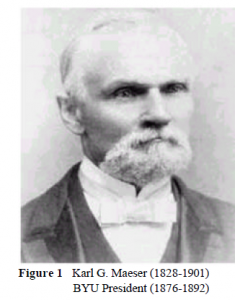Sarah Jane Sandberg and Professor Brad Wilcox, Teacher Education
A chalk circle of honor, a memorial building, a statue: each of these items stand today on Brigham Young University campus as an echo from the past of a man who educated with love. Nearly a century after his death, the legacy of Karl G. Maeser is still remembered. Photographs of this man capture his penetrating eyes and feet ready to march forward in the cause of truth. Who was this man of excellence and character? Why did his students revere him to such a degree?
Karl G. Maeser (Fig.1) was born in Meissen, Germany, on 16 January 1828. He was educated in both parochial and private school settings, attending the Gymnasium Kreuz Schule at Dresden and the Normal School at Friedrichstadt. Maeser lived in Germany during a time in which it was popular to pursue a focused area of research and study. But rather than attend the prestigious schools of higher education, Maeser chose a vocation at a Normal School, a school designed to train and educate teachers.
Following his baptism into The Church of Jesus Christ of Latter-day Saints in the fall of 1855, Maeser and his wife, Anna, traveled to Utah to join the other Saints. Here, Maeser was able to serve, sacrifice, and educate. He taught both children and adults in the Salt Lake City, Utah area. In the spring of 1876, Karl G. Maeser was called to serve as the new principal of the Brigham Young Academy in Provo, Utah. Brigham Young charged Maeser to always teach with the Spirit of the Lord, even if it was a basic principal such as the alphabet or the multiplication tables.
The combination of Maeser’s brilliant intellect and unconquerable spirit created an energy in the classroom that captivated the attention of students. His personal style and ability to individually connect with students allowed him to be a positive mentor in their lives.
Maeser’s book, School and Fireside,1 outlines and articulates his educational philosophies. While these methods are new and revolutionary in some respects, it is important to note the way in which Johann Heinrich Pestalozzi and Ferdinand Froebel influenced Maeser’s ideas of education.
Johann Pestalozzi, born in 1746, was a teacher and a reformer of education. He moved beyond acquiring knowledge through textual analysis. He encouraged teachers, instead, to incorporate the use of objects in their pedagogy practices to help students grasp abstract concepts. These object lessons proved to be very effective in teaching students. If education is provided, there is progression; if people only have physical needs met, there will be regression. Maeser’s book and teaching practices reflect many Pestalozzian ideas.
Friedrich Froebel, a follower of Pestalozzi born in Germany in 1782, is considered to be the founder of the Kindergarten. He firmly believed that children need the opportunity to grow and develop in a loving environment. He used colored paper, clay, sand, pencils, and paints to introduce children to the laws of nature. He also taught using music, games, and action songs. Maeser emulated these practices in his schools throughout Utah.
The critical period of education is between the years of infancy and pre-school. Maeser stressed the importance of education both at home (the “Fireside” component in his book, School and Fireside) and at school. He recognized and encouraged the role of the mother in the education of the child. He was also a champion in the cause of education for women.
Maeser strongly emphasized the development of character in his students. He believed education should change not only the mind of the student, but also the heart. He says, “the formation of character depends upon the nature of the moral training which accompanies intellectual advancement” (Maeser 43). Character stands above academic pursuits in educating people.
A poster displayed on BYU campus captures Maeser’s intense commitment to honor: “I have been asked what I mean by word of honor. I will tell you. Place me behind prison walls—walls of stone ever so high, ever so thick, reaching ever so far into the ground—there is a possibility that in some way or another I may escape; but place me on the floor and draw a chalk line around me and have me give my word of honor never to cross it. Can I get out of the circle? No. Never! I’d die first!”
In July of 2001, I traveled to Karl G. Maeser’s birthplace in Meissen, Germany, with members of the Maeser family. The life of Maeser became more brilliant as I visited his home, his schools, and other places in Meissen and Dresden where he developed his character.
While in Germany, I met Hermann Wiedenroth, an antique bookseller, who has organized a museum exhibit on Karl G. Maeser. One highlight included learning of a missing link in the history of Maeser’s education; what was once thought to be the Budich school is really the Bezirks school.
I also attended the dedication ceremony of the Karl G. Maeser statue in Dresden, Germany. The feeling of love and connection during the celebration was electric.
My research on the life and legacy of Karl G. Maeser has changed my life as an educator. I look forward to taking my discoveries into the elementary school classroom following my graduation from Brigham Young University.
References
- Maeser, Karl G. School and Fireside. Skelton and Company, 1898

